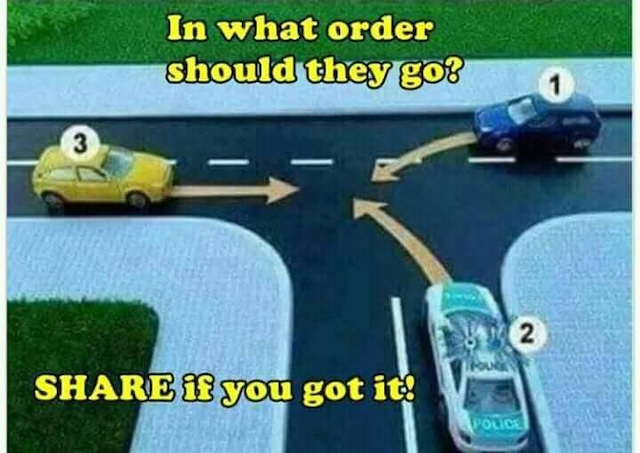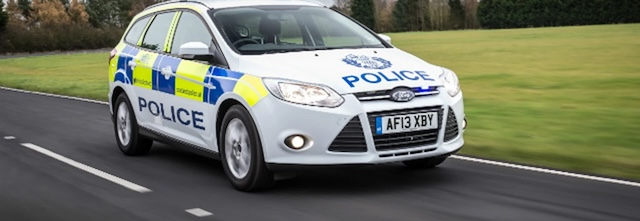Intersections can be one of the most confusing parts of driving, especially when multiple vehicles approach at the same time. The question seems simple: Who has the right of way? But many people struggle with the details, often making mistakes that could lead to dangerous situations on the road.
In this scenario, three vehicles are approaching an intersection—a police car, a car going straight, and another turning left. Can you determine the correct order of movement? Let’s break it down and test your understanding of traffic rules!
Why Do So Many People Get This Wrong?

Right-of-way rules might seem straightforward, but there are plenty of reasons why people make mistakes in these situations. Here are some of the most common errors:
- Ignoring emergency vehicles – Many drivers forget that police cars, ambulances, and fire trucks have priority when their sirens and lights are on.
- Misunderstanding left-turn rules – A left-turning vehicle must always yield to oncoming traffic unless otherwise directed.
- Overlooking road signs and signals – Traffic lights, stop signs, and right-of-way indicators play a critical role in determining which car moves first.
- Making assumptions – Some drivers assume their own path is the priority without checking for other vehicles’ movements.
Now that we know where most people go wrong, let’s go through the correct process of determining right-of-way in this scenario.
Step-by-Step Breakdown: Who Goes First?
Step 1: Identify Any Emergency Vehicles
The first thing to check is whether an emergency vehicle is present. In this case, we have a police car (Vehicle 2).
If the police car has its sirens on, it automatically has the right of way over all other vehicles. Emergency responders are allowed to move first in most traffic situations, provided it is safe to do so.
So, if the police car is responding to an emergency, it will go first, and the other two vehicles must wait.
Step 2: Analyze the Remaining Vehicles
Once the police car has moved through the intersection, the next decision comes down to the two remaining vehicles:
- Vehicle 1 (Blue Car) is making a left turn.
- Vehicle 3 (Yellow Car) is going straight.
According to standard right-of-way rules, a car traveling straight always has priority over a car making a left turn unless directed otherwise by a signal or stop sign.
This means that after the police car moves, the yellow car traveling straight will go next.
Step 3: The Last Vehicle to Move
Since the blue car (Vehicle 1) is making a left turn, it must yield to both the police car and the straight-moving vehicle.
This means Vehicle 1 will be the last to move through the intersection.
Final Answer: The Correct Order of Movement

Now that we’ve analyzed the scenario carefully, here is the correct order of movement:
- Police Car (Vehicle 2) moves first – Emergency vehicles take priority if their sirens are activated.
- Yellow Car (Vehicle 3) goes second – Since it is traveling straight, it has the right of way over turning traffic.
- Blue Car (Vehicle 1) moves last – Left-turning vehicles must yield to both emergency responders and straight-moving traffic.
Did you get it right? If not, don’t worry—many people make mistakes when determining the correct right-of-way order.
Why Understanding Right-of-Way Rules Is Crucial
Mastering right-of-way rules is essential for safe and efficient driving. Intersections are one of the most common places for accidents to occur, and a misunderstanding of traffic laws can lead to dangerous collisions.
Key reasons to learn these rules:
- Prevents accidents – Knowing when to yield keeps traffic flowing smoothly and reduces the risk of crashes.
- Reduces confusion – When all drivers understand who should go first, hesitation and mistakes are minimized.
- Improves road safety – Proper intersection etiquette helps protect pedestrians, cyclists, and other motorists.
How Well Did You Do?

Did you figure out the correct order on your first try, or did this puzzle challenge your traffic knowledge? Share your answer in the comments and let us know what you thought!
Understanding right-of-way rules is a key part of becoming a safer and more confident driver. If you enjoyed this challenge, try more traffic puzzles and test your knowledge further. Who knows? The next time you approach a tricky intersection, you might be the only one who knows exactly what to do!


